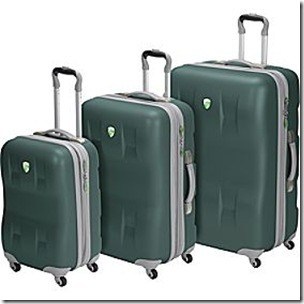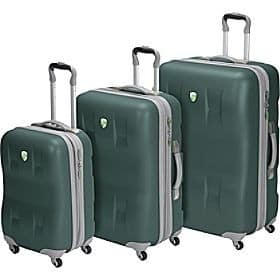Last Updated on April 13, 2025 by Dawn Head
I only use my suitcase a few times a year but when I do, it’s definitely used. In and out of the car and public transportation, taking it on flight, rolling it on the ground. It endures rough handling.
When my gifted luggage started falling apart after just a few years, it made me think: there must be a more eco-conscious way to travel with my stuff. Choosing green luggage is one step forward in reducing my environmental footprint.
Some companies are starting to offer more sustainable options. For instance, Patagonia crafts bags from recycled materials, and Heys’ Eco Case is made entirely from recycled plastic – even in green!
Sierra Club also offers luggage focused on various eco-friendly aspects, and Eco Traveler provides a hemp, PVC-free carry-on set.
Luggage repair
Before thinking about getting new luggage, the first question to ask (if you already have luggage) is Can my current bag be fixed?
Before you even browse those tempting new styles at Target, Walmart, or TJ Maxx (which is very fun to do) take a good look at what you’ve got. Is it just a broken zipper pull, a wobbly wheel, or a torn seam? These are often relatively easy and inexpensive repairs.
Getting your luggage repaired not only saves you money but is also the most eco-friendly option. You’re extending the life of a product that already exists, avoiding the energy and resources needed to create something new.
While I might enjoy a wander through the luggage aisle to see what’s new, I know that the greenest “tip” for buying luggage isn’t about buying at all. It’s about continuing to use and care for what you already have for as long as possible.
How to find eco-luggage
Even though truly “green” luggage is still somewhat limited, there are smart choices we can make with conventional bags to ensure they are a little kinder to the planet. Here are some things to look for and consider:
Weight of Bag
It’s surprising just how much some empty luggage can weigh. You want the suitcase to be sturdy but extra weight is a burden for you and the planet.
When everyone’s empty bag contributes several pounds, the collective result is a significant amount of extra energy needed just to transport the luggage itself.
When searching for greener luggage, prioritize finding a sturdy bag that is also lightweight. If you’re looking for lightweight luggage, check out our lightest luggage article.

Size of Bag
The golden rule of luggage size is to get what you truly need for your typical trips. While packing light is the ultimate goal, it’s better to buy one slightly larger, durable bag you’ll use consistently than to end up buying multiple bags because your first choice was too small.
That just creates more waste in the long run.
On the flip side, resist the urge to go too big! The more space you have, the more tempting it is to fill it with unnecessary items. This is super hard for me to not pack until my suitcase it bursting.
I’m a huge fan of carry-on sized luggage. It’s a win-win for the environment and my wallet. Less weight and bulk mean less fuel consumption during transport. The immediate bottom line savings is no checked bag fees. And that’s more important than ever now that Southwest Airlines is not letting travelers check two bags for free (announced spring 2025).
Aside from moving my child to college and doing so in suitcases while flying, I can’t remember the last time I took a larger, non-carry-on sized bag.
Expandable/Multipurpose Bag
This may seem contradictory to what I just said. But having an expandable carry-on bag can actually mean owning fewer luggage pieces overall. This is a big win for the “reduce” part of reduce, reuse, recycle.
You might usually need a carry-on for shorter trips and a larger checked bag for when you are going for an extended stay or special event, etc. An expandable carry-on offers the best of both worlds. Or if you are bringing stuff with you than you won’t bring both ways (in the case of me bringing my child to college or sometimes I bring stuff to my family or they give me stuff to bring home).
With an expandable bag, you can travel light one way, say on the way to your destination, and then expand it for the return journey if needed.
This flexibility can prevent you from buying a separate, larger suitcase that you might only use once or twice a year. Choosing luggage that can serve multiple purposes is a smart way to consume more consciously.
Bag material
If possible, take a close look at what your luggage is made of. Opting for bags that are PVC-free is a great step, as PVC can release harmful chemicals during its production and disposal.
Even better are bags made from recycled materials. Giving new life to existing resources helps to reduce the demand for virgin materials and can lower the environmental impact of manufacturing.
For smaller, packable bags – the kind you might bring along for shopping so you can skip single-use plastic bags – consider materials like hemp or organic cotton. These natural fibers are usually more sustainable to produce than synthetic options.
Every little bit helps!
While it might be harder to find large suitcases made entirely of these materials right now, you can still choose bags that at least incorporate recycled content or are free from harmful substances like PVC.
Durability
As I mentioned initially, flimsy, cheap luggage often ends up in the landfill. That cycle of buying, breaking, and replacing is costly, frustrating, and also adds to waste.
Investing in a well-made bag from a reputable brand, with good reviews and ideally a solid warranty, can save you money and reduce waste in the long run. Pay attention to how sturdy the bag feels in the store.
Check the zippers, seams, handles, and wheels (if applicable). These are often the first points of failure.
You might have to spend a little more for a durable piece of luggage, but think of it as a long-term solution. By choosing quality over cheapness, you’re less likely to be buying a new suitcase every few years, which is better for your wallet and definitely better for the Earth.
True eco-luggage is still be hard to find. However, by focusing on durability, repair, and smart features, we can all travel a little lighter and enjoy our adventures with a clearer conscience.
Related content:
- Samsonite Winfield vs Samsonite Omni Carry On Luggage
- Tips for packing lighter
- Kids carry-on luggage, bring the things your kids need!

